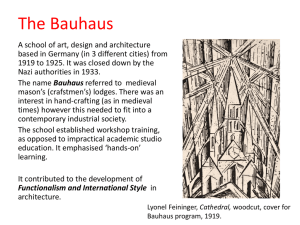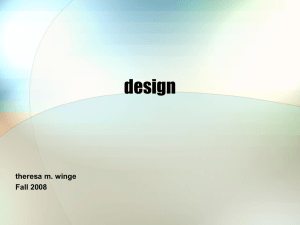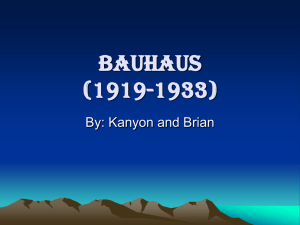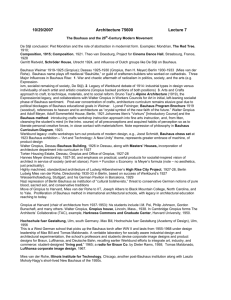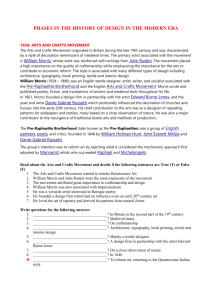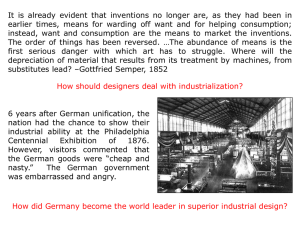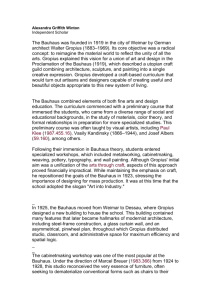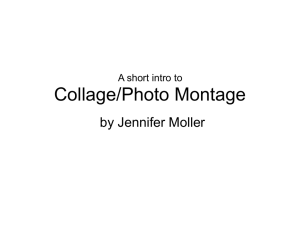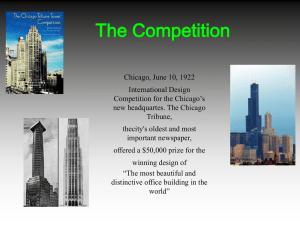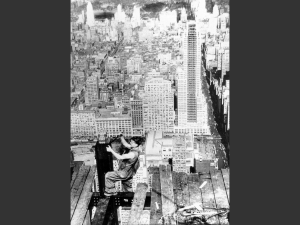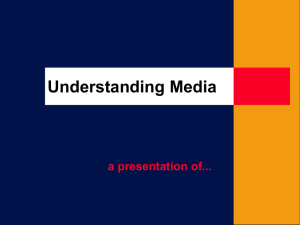Bauhaus Vorkurs History: Johannes Itten 1919-1922
advertisement
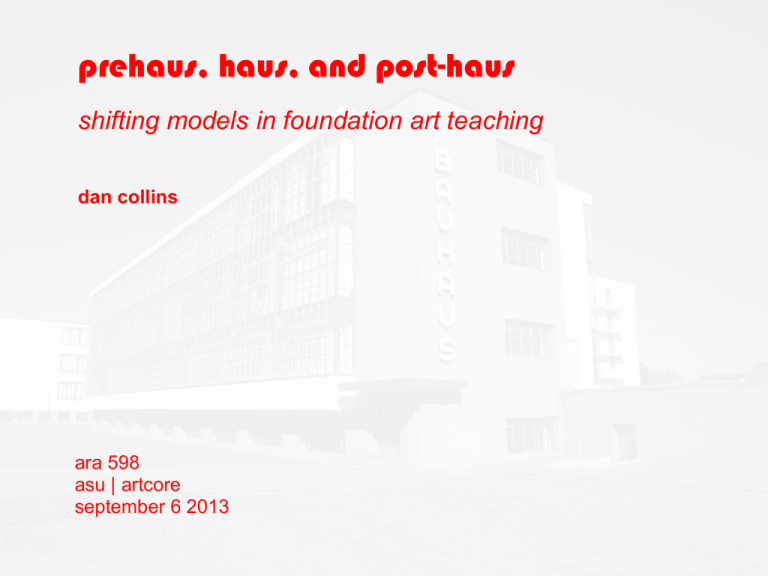
prehaus, haus, and post-haus shifting models in foundation art teaching dan collins ara 598 asu | artcore september 6 2013 bauhaus history The Bauhaus was born in 1919 after Walter Gropius was invited to combine the schools of art and craft in Weimar, Germany. Ordinary craftsmen as well as famous artists such as Paul Klee and Vassily Kandinsky were hired to teach. Gropius felt that an understanding of materials, which was taught in workshops that included metalwork, carpentry, interior design, construction, and furniture making, must be mastered before architecture. His goal was to create: A clear, organic architecture, whose inner logic will be radiant and naked, unencumbered by lying facades and trickeries; we want an architecture adapted to our world of machines, radios and fast motor cars, and architecture whose function is clearly recognizable in the relation of its forms (Stokstad 1981). REHAUS, HAUS, AND POSTHAUS Bauhaus Walter Gropius 1926 Dessau, Germany bauhaus history: not monolithic Three different geographic locations with different curricular emphases: • Weimer (1919 - 1925) • Dessau (1925 – 1932) • Berlin (1932 – 1933) Three different architect-directors: • Walter Gropius from 1919 to 1928, • Hannes Meyer from 1928 to 1930 and • Ludwig Mies van der Rohe from 1930 until 1933 Weimar (1919-1925) Dessau (1925 – 1932) Berlin (1932 – 1933) Bauhaus History: Weimar (1919 – 1925) The school had its roots in an arts and crafts school founded in 1906 and directed by Belgian Art Nouveau architect Henry van de Velde, a Belgian.. Bauhaus History: Berlin (1932 – 1933) In late 1932, Mies rented a derelict factory in Berlin to use as the new Bauhaus with his own money. The students and faculty rehabilitated the building, painting the interior white. The school operated for ten months without further interference from the Nazi Party. In 1933, the Gestapo closed down the Berlin school. Mies protested the decision, eventually speaking to the head of the Gestapo, who agreed to allow the school to re-open. However, shortly after receiving a letter permitting the opening of the Bauhaus, Mies and the other faculty agreed to voluntarily shut down the school (1925 – 1932) R E H A U S , H A Bauhaus U S , A N D History: P O S T H ADessau US Bauhaus Walter Gropius 1926 Dessau, Germany Bauhaus Vorkurs history: not monolithic. Three different geographic locations with different “foundations coordinators”: • Weimer (1919 – 1925) Johannes Itten wrote the original Vorkurs emphasizing material discovery and personal expression. • Dessau (1925 – 1928) Lazlo Moholy Nagy rewrote the Vorkurs to emphasize integration of art, technology, and industry. Albers assisted. • Dessau (1928 – 1933) Josef Albers directed the Vorkurs. • Berlin (1932 – 1933). Albers was assistant director in Berlin under Mies. Johannes Itten at Weimar (1919-1925) Lazlo Moholy Nagy Dessau (1925 – 1928) Josef A;lbers Dessau (1920 – 1931) Berlin (1932 – 1933) Bauhaus Curriculum Abenakt = evening act gruppe werk = group work ; werkstatt = Bauhaus Vorkurs History: Johannes Itten 1919-1922 From 1919 to 1922 the school was shaped by the pedagogical and aesthetic ideas of Johannes Itten, who taught the Vorkurs or 'preliminary course' that was the introduction to the ideas of the Bauhaus. [Itten was heavily influenced in his teaching by the ideas of Montessori, Pestolezzi, Franz Cižek and Friedrich Fröbel. Note “spiritual” clothing Bauhaus Vorkurs History: Johannes Itten 1919-1922 Itten was trained in teaching elementary students using Froebel’s methods—including the famous Froebel “gifts” (sets of blocks and other manipulables which also had a great impact on Frank Lloyd Wright’s and Buckminster Fuller’s development) Friedrich Froebel (1782 – 1852) was the inventor of the modern Kindergarten and Froebel “Gifts” including his famous Froebel Blocks. Bauhaus Vorkurs History: László Moholy-Nagy 1923 - 1928 In 1923, Moholy-Nagy replaced Johannes Itten as the instructor of the foundation course at the Bauhaus. This effectively marked the end of the school’s expressionistic leanings and moved it closer towards its original aims as a school of design and industrial integration. He coined the term “the New Vision” for his belief that photography could create a whole new way of seeing the outside world that the human eye could not. While studying at the Bauhaus, Moholy’s teaching in diverse media — including painting, sculpture, photography, photomontage and metal — had a profound influence on a number of his students.. Note “worker” clothing Bauhaus Vorkurs History: Josef Albers 1928 - 1933 Before enrolling as a student at the Bauhaus in 1920, Josef had been a school teacher in his hometown of Bottrop, in the northwestern industrial Ruhr region of Germany Once he was at the Bauhaus, he worked primarily in stained and sandblasted glass, first making glass assemblages from detritus he found at the Weimar town dump, then sandblasting glass constructions and designing large stained-glass windows for houses and buildings. He also designed furniture, household objects, and a typeface, and developed a keen eye as a photographer. In 1925 he was the first Bauhaus student to be asked to join the faculty and become a "master" there. By 1933, when pressure from the Nazis forced the school to close, Josef Albers had become one of its best-known artists and teachers. Note “spats” “Modernist” Foundations (20th c.) “postHaus” Foundations (21st. C.) 1. Top down teaching model (“sage on the stage”) 1. Bottom up “participatory” ( “guide on the side”). 2. Design solutions free of context 2. Context driven 3. Passive acceptance of ideas 3. Active questioning 4. Static elements and principles 4. Dynamic elements and principles 5. Drive towards simplicity, clarity of design 5. Formal and conceptual complexity. 6. Western focus exclusively 6. Range of historical and cultural sources 7. Discipline centric 7. Student and/or community centric 8. Subjective response sufficient 8. Subjective response + objective analysis 9. Unexamined “universal” meanings accepted without careful weighing of evidence 9. Scrutinized “local” meanings and judgments from weighing multiple pieces of evidence 10. Single discipline 10. Interdisciplinary in scope 11. Skill based 11. Idea based 12. One size fits all 12. Custom tailored 13. Resolved, independent, fixed “codes” 13. Open-ended, dependent, open-source 14. One schedule fits all 14. Thin slicing of schedule for best fit (Kallish) 15. Personal expression (only) 15. Empathy with other points of view 16. Individual intelligence 16. Collective intelligence - Socially engaged 17. Uni-modal with single pathway for navigation 17. Multi-modal with the ability to follow the flow 18. Emphasis on “singular point of view” 18. Emphasis on “negotiation” and “relationships” 19. Single “right” answer 19. Multiple contingent possibilities 20. Analog. Continuous. Unique. 20. Digital. Discrete. Commensurable. 21. Broadcast. Professionally produced. TV. 21. Broadband. Co-created content. Wikis. The irony of our “Bauhaus Foundations” is… How many of us are ONLY echoing the “Elements and Principles” of Arthur Wesley Dow or Johannes Itten’s “theory of contrasts” and not the integrated curriculum and responsibility to the broader social context that the original Bauhaus espoused? While many Bauhaus ideas were integrated into American popular culture, the reception of these ideas reduced “a complex and multifaceted phenomenon to a simple formula,” most often made visible in architecture. Bauhaus ideas in America mainly become associated with a well-known stylistic “look,” while the context, writing, and teaching of the master educators of the Vorkurs were largely buried by time. --Fern Lerner, Foundations for Design Education: Continuing the Bauhaus Vorkurs Vision, Studies in Art Education, Spring 2005. What’s Your Teaching Philosophy? • John Dewey, Elliot Eisner X X X Lucy Lippard What’s Your Teaching Philosophy? Student Centered (Personal Growth / Self-Actualization) • Friedrich Froebel – Developed the modern Kindergarten and “Froebel Blocks.” Maria Montessori - independence, freedom within limits, respect for child’s nature Johannes Itten – Developed the first Vorkurs at the Bauhaus (1919 – 1922) John Dewey – Child-centered learning Jean Piaget – Stages of human development Discipline Centered (Art for Art’s Sake) Clement Greenberg – Modernist art critic X Lazlo Moholy Nagy – Led the Vorkurs from 1923 – 1928 at the Bauhaus Mies Van Der Rohe – Director of the short-lived X Berlin Bauhaus (1932 – 33) Josef Albers – Led the Vorkus from 1928 - 1933 X Society Centered (Socially Engaged Art – SEA) Walter Gropius, Founding Director, Bauhaus (?) Lucy Lippard – Environmental/Social Activist and Art Critic Judy Baca – Muralist in So Cal. represented darker side of racial inequities Tim Rollins – Kids of Survival Pablo Helguera (Handbook: Education for Socially Engaged Art) Foundations for a 21st c. Curriculum Art Educator, June King McFee wrote in 1978 of “the arts as reflectors and modifiers of a social change.” The kind of “multivariant problem-solving” she advocated would include: “the visual as well as the conceptual, the affective as well as the intellectual, the social as well as the physical, and the aesthetic as well as the economic. Monumental changes are needed in education to prepare students to think multivariantly in these dimensions… McFee, J.K. (1978). Art abilities in environmental reform. Art Education, 31(4), 9 – 12. Foundations for a 21st c. Curriculum A 21st century curriculum needs to be responsive to the dynamic and emergent conditions and requirements of its culture. The objective elements (line, shape, texture, value, etc) and principles (unity, emphasis, balance, rhythm, scale/proportion, etc.), while relevant to studio practice, provide little foundation in those skills and strategies (“markers for success”) that are essential in our shared and increasingly interconnected world. Rather than providing recipes that effectively echo “modernist” standards and assumptions, a 21st century curriculum should provide the critical and empathetic skills key to operating successfully in any media, circumstance, modality, or cultural context. Dan Collins, MFA, PhD artCORE Coordinator School of Art Arizona State University Tempe, AZ 85287-2505 dan.collins@asu.edu
